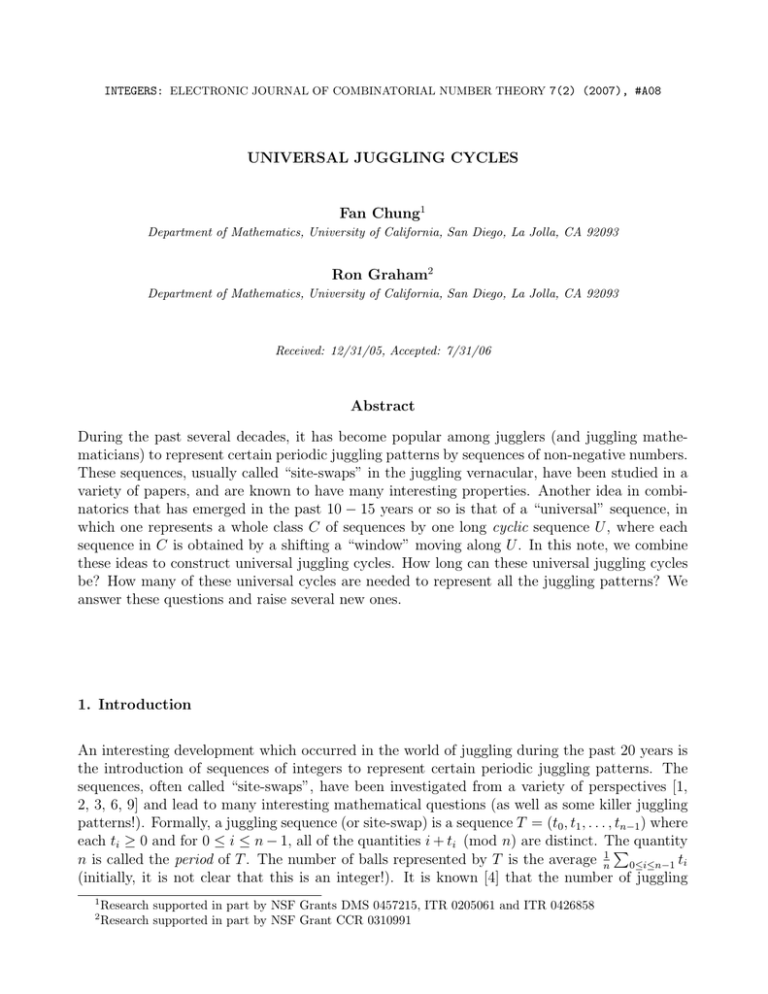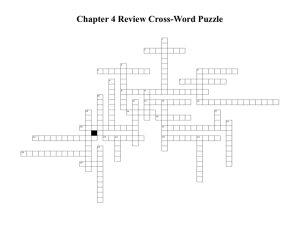UNIVERSAL JUGGLING CYCLES Fan Chung Ron Graham
advertisement

INTEGERS: ELECTRONIC JOURNAL OF COMBINATORIAL NUMBER THEORY 7(2) (2007), #A08 UNIVERSAL JUGGLING CYCLES Fan Chung1 Department of Mathematics, University of California, San Diego, La Jolla, CA 92093 Ron Graham2 Department of Mathematics, University of California, San Diego, La Jolla, CA 92093 Received: 12/31/05, Accepted: 7/31/06 Abstract During the past several decades, it has become popular among jugglers (and juggling mathematicians) to represent certain periodic juggling patterns by sequences of non-negative numbers. These sequences, usually called “site-swaps” in the juggling vernacular, have been studied in a variety of papers, and are known to have many interesting properties. Another idea in combinatorics that has emerged in the past 10 − 15 years or so is that of a “universal” sequence, in which one represents a whole class C of sequences by one long cyclic sequence U , where each sequence in C is obtained by a shifting a “window” moving along U . In this note, we combine these ideas to construct universal juggling cycles. How long can these universal juggling cycles be? How many of these universal cycles are needed to represent all the juggling patterns? We answer these questions and raise several new ones. 1. Introduction An interesting development which occurred in the world of juggling during the past 20 years is the introduction of sequences of integers to represent certain periodic juggling patterns. The sequences, often called “site-swaps”, have been investigated from a variety of perspectives [1, 2, 3, 6, 9] and lead to many interesting mathematical questions (as well as some killer juggling patterns!). Formally, a juggling sequence (or site-swap) is a sequence T = (t0 , t1 , . . . , tn−1 ) where each ti ≥ 0 and for 0 ≤ i ≤ n − 1, all of the quantities i + ti (mod n) are distinct. The ! quantity 1 n is called the period of T . The number of balls represented by T is the average n 0≤i≤n−1 ti (initially, it is not clear that this is an integer!). It is known [4] that the number of juggling 1 2 Research supported in part by NSF Grants DMS 0457215, ITR 0205061 and ITR 0426858 Research supported in part by NSF Grant CCR 0310991 INTEGERS: ELECTRONIC JOURNAL OF COMBINATORIAL NUMBER THEORY 7(2) (2007), #A08 2 sequences with period n and at most b balls is exactly (b + 1)n . For example, with n = 3, b = 2 we have the 27 juggling sequences: 000, 003, 030, 300, 012, 120, 201, 111, 015, 042, 312, 123, 150, 420, 114, 141, 411, 222, 204, 231, 501, 006, 060, 600, 033, 303, 330. Our goal in this note is to try and pack these juggling sequences together as tightly as possible in the form of cycles of integers where by looking at a sliding window of width n, we see each of the possible juggling sequences of period n and at most b balls exactly once. It will turn out that it is not possible to do this using just one “universal” cycle. However, we can partition the juggling sequences rather nicely into a disjoint collection of cycles. For example, for the case of n = 3 and b = 2, the collection of universal cycles consists of 0003033006, 012312042015, 1114, 222. That is, each of the 27 juggling sequences appears exactly once as a window of width 3 goes around each of the 4 cyclic sequences shown as seen in Figure 1. (The detailed definitions will be given later.) Figure 1: UJC’s for n = 3 and b = 2. How are these universal cycles constructed and how many such cycles are there for given n and b? What are the sizes of these cycles? In this note, we will answer these questions and mention a number of open problems concerning universal juggling cycles. INTEGERS: ELECTRONIC JOURNAL OF COMBINATORIAL NUMBER THEORY 7(2) (2007), #A08 3 2. The Number of UJC’s For a given period n and bound b on the number of balls, we wish to determine the minimum number of universal juggling cycles (or, UJC’s for short) needed to represent all juggling patterns with period n and at most b balls. We will see that this is a well-defined quantity which in fact just counts the number of connected components in a certain graph (see Section 3). We note that for different b’s, the answer can be quite different. For example, for n = 3 and b = 1, there are only three components — 0003, 012, 111. For n = 3 and b ≥ 2, there are exactly four components. Before we address the general case, we first examine some useful properties of a universal juggling cycle. A juggling sequence t0 , t1 , . . . , tn−1 of length n can be associated with a unique permutation π in S(n) where π(i) ≡ ti + i (mod n). Of course, we require 1 ≤ π(i) ≤ n. This fact follows an immediate consequence of the definition of a juggling sequence. A permutation π in S(n) can be associated with many juggling sequences. We say that a juggling sequence is a basic juggling sequence if it has the smallest sum of entries among all juggling sequences associated with the given permutation. (Note that there will not be ties since all other juggling sequences associated with the same permutation have sums at least n more than the basic juggling sequence.) For example, the basic juggling sequence associated with the permutation π(1) = 3, π(2) = 2, π(3) = 1 is (2, 0, 1). From this definition, we have the following: Fact 1 Each juggling sequence is associated with a permutation which in turn is associated with a (unique) basic juggling sequence. We say a juggling sequence of period n is contained in a UJC if it appears as a shifted window of width n. Fact 2 In a universal juggling cycle, any two juggling sequences of period n have basic juggling sequences which are cyclic shifts of each other. Proof. It suffices to show that two consecutive windows of width n are associated with basic juggling sequences which are cyclic shifts of each other. Suppose a juggling sequence si , si+1 , . . . , si+n−1 is in the UJC. It is known [1] that i+n−1 " sj ≡ 0 (mod n). i+n " sj ≡ 0 (mod n). j=i Similarly, j=i+1 INTEGERS: ELECTRONIC JOURNAL OF COMBINATORIAL NUMBER THEORY 7(2) (2007), #A08 4 Therefore we have si ≡ si+n for all i. Therefore two consecutive windows of width n are cyclic shifts of each other. Hence, this is true for any two shifted windows of width n. ! We wish to prove the following: Theorem 1 For given integers n and b ≥ n − 1, the number of UJC’s of period n and at least b balls is the number of equivalence classes of basic juggling sequences, where the equivalence relation is defined by cyclic shifts. We will give a constructive proof for the above theorem in the next section. In fact, the proof will include an algorithm for generating the collection of UJC’s for given n and b. Here we will use Theorem 1 to prove the following: Theorem 2 For a given integer n, the number of UJC’s for juggling sequences of period n and at least b ≥ n − 1 balls, denoted by g(n), satisfies g(n) = 1" n δ n δ!( ) φ( ) n δ δ δ|n where φ(n) is the usual Euler φ function, i.e., φ(n) denotes the number of integers less than n and relative prime to n. (Note that the value of g(n) does not depend on b.) Proof. Let fn (d) denote the number of permutations in S(n) which are associated with a juggling sequence with minimum period d. Claim 1: " δ|d n fn (δ) = d!( )d . d Proof of Claim 1: If a permutation π is associated with a juggling sequence of period d, we have π(i + d) − (i + d) ≡ π(i) − d (mod n). In other words, π(i + d) ≡ π(i) + d (mod n) for all i. We have d! ways to choose the sub-permutation among π(1), . . . , π(d). For each j with 1 ≤ j ≤ n/d, there is a choice for the least element among π(j), π(j + d), . . . , π(j + (n/d − 1)d). That explains the term ( nd )d . This proves the claim. Claim 2: fn (d) = " δ|d where µ denotes the usual Möbius function. d n µ( )δ!( )δ δ δ Claim 2 is a consequence of the Möbius inversion formula (see [10]). Now, the number g(n) of components satisfies g(n) = "1 d|n d fn (d). INTEGERS: ELECTRONIC JOURNAL OF COMBINATORIAL NUMBER THEORY 7(2) (2007), #A08 5 Therefore, we have g(n) = "1" d d|n = " δ|n n "1 d δ!( )δ µ( ) δ d δ d δ|d|n n " 1 δ!( )δ µ(k) δ kδ δ|n k|(n/δ) " n " 1 = (δ − 1)!( )δ µ(k) δ k = " δ|d d n µ( )δ!( )δ δ δ δ|n k|(n/δ) " n φ(n/δ) = (δ − 1)!( )δ . δ n/δ δ|n Here we use the known equality [8] "1 k|N k Therefore, we have g(n) = µ(k) = φ(N ) . N 1" n δ n δ!( ) φ( ) n δ δ δ|n as desired. ! The formula in Theorem 2 yields g(4) = 10 and g(5) = 28. For many other values of n, we can also compute g(n): Corollary 1 If n is a prime, then for b ≥ n − 1 we have g(n) = (n − 1)! + n − 1. 3. Constructing UJC’s To prove Theorem 1, we will construct the UJC’s by using techniques similar to the construction of universal cycles in [5]. From Facts 1 and 2, we consider permutations in S(n) and the basic jugging sequences from which we have all juggling sequences with period n and at most b balls. Now, we construct a directed graph G using the juggling sequences. The vertices are subsequences of length n − 1 that appear in the juggling sequences as the first n − 1 entries or the INTEGERS: ELECTRONIC JOURNAL OF COMBINATORIAL NUMBER THEORY 7(2) (2007), #A08 6 last n − 1 entries. Each juggling sequence (t0 , t1 , . . . , tn−1 ) is associated with an edge from the vertex (t0 , . . . , tn−2 ) to the vertex (t1 , . . . , tn−1 ). The problem of finding UJC’s is equivalent to the problem of covering the edges of G by edge-disjoint cycles. Furthermore, to determine the number of UJC’s is the same as determining the number of connected components in G. Hence, it suffices to prove the following claims. Claim 3: For each vertex in G, the indegree is equal to the outdegree. Proof of Claim 3: For a vertex v ! = (r1 , r2 , . . . , rn−1 ), the outdegree of v is the number of nonnegative integers m such that n−1 i=1 ri + m = kn for some integer k ≤ b. In fact, each solution for m gives an edge from v to (r2 , . . . , rn−1 , m) and an edge from (m, r1 , . . . , rn−1 ) to v. Thus, every vertex in G has its indegree equal to its outdegree. It is then an easy exercise [11] to see that all edges can be partitioned into cycles so that the number of cycles is equal to the number of strongly connected components of G. Claim 4: For all juggling sequences which are associated with basic juggling sequences in the same equivalence class, the corresponding edges are all in one connected component. Proof of Claim 4: First we note that all basic juggling sequences in an equivalence class form a cycle since they are cyclic shifts of one another. For a juggling sequence (t0 , t1 , . . . , tn−1 ), suppose the associated basic juggling sequence is (r0 , r1 , . . . , rn−1 ). We can easily construct a path using edges (ti , . . . , tn−1 , r0 , . . . , ri−1 ) for i = 0, . . . , n − 1, to reach the basic juggling sequence from the given juggling sequence. In a similar way, we can construct a path from (r0 , r1 , . . . , rn−1 ) to (t0 , t1 , . . . , tn−1 ). When b ≥ n − 1, all basic juggling sequences have at most b balls. Thus, every permutation generates a basic juggling sequence. From Claims 3 and 4, the number of UJC’s is precisely the number of equivalence classes of basic juggling sequences. This completes the proof of Theorem 1. In Figure 1, the directed graph corresponding to the case of n = 3, b = 2 is illustrated. We note that there are exactly four UJC’s. However, for the case of n = 3 and b = 1, the corresponding graph has 8 edges and there are only three UJC’s since the basic juggling sequence 222 requires two balls. 4. The Sizes of the UJC’s As we have seen in the previous section, each UJC can be identified by a unique cyclic equivalence class of basic juggling sequences. As we can see from the example in Figure 1, the UJC’s may have different lengths. We now consider the problem of determining the sizes of the UJCs. We consider a UJC that is associated with (the equivalence class of) a basic juggling sequence (r0 , . . . , rn−1 ). Suppose the basic juggling sequence (r0 , . . . , rn−1 ) is a pattern with d balls. In particular, the sum of all ri ’s is dn, and the associated permutation has d drops. Recall that INTEGERS: ELECTRONIC JOURNAL OF COMBINATORIAL NUMBER THEORY 7(2) (2007), #A08 7 an integer i is a drop of a permutation π if π(i) < i. We need the following fact concerning the cyclic shifts of a juggling sequence. Lemma 1 Any two cyclic shifts of a juggling sequence t0 , t1 , . . . , tn−1 have associated permutations with the same number of drops. Proof. If suffices to consider the cyclic shift (t1 , . . . , tn−1 , t0 ) with an associated permutation π # . We need to show that π # has the same number of drops as the associated permutation π of the juggling sequence t0 , t1 , . . . , tn−1 . Since π(i) ≡ ti + i (mod n), we have π # (i) ≡ ti+1 + i ≡ π(i + 1) − 1 (mod n) with the convention that π(n) = π(0). Therefore π # (i) − i = π(i + 1) − 1 − i if π(i + 1) %= 1. Now we consider the number drops of π # . There are two cases: Case 1: π(1) = 1. We have π # (n) = n. For 1 ≤ i ≤ n − 1, i is a drop of π # if and only if i + 1 is a drop of π. Therefore π and π # have the same number of drops. Case 2: π(1) > 1 and π(i + 1) = 1 for some i ≥ 1. Thus,π # (i) = n and so i is not a drop for π # but i + 1 is a drop for π. However, π # (n) − n = π(1) − 1 − n < 0 so n is a drop for π # but 1 is not a drop for π. For j satisfying i < j < n or 1 ≤ j < i, j is a drop of π # if and only if j + 1 is a drop for π. Therefore we conclude that π and π # have the same number of drops. ! From the above lemma, we see that all the permutations associated with the juggling sequences in a UJC have the same number of drops. It is not hard to see that counting the number of juggling sequences with d + k balls is the same problem as counting the number of ways of placing k identical balls into n distinct bins (see [2]). Therefore, the number of such arrangements is exactly # $ n−1+k . k Consequently, the number of juggling sequences with at most b = d + k balls is exactly $ # $ k # " n−1+s n+k = . s k s=1 Therefore we have proved the following: Theorem 3 For given n and b, the length of a UJC (for juggling sequences with period n and having at most b balls) with equivalence class C and with all its permutations having d drops is # $ n+b−d |C| . n For example, in Figure 1, the UJC containing 000 has length 10. Another consequence of Theorem 3 is the following equality: " #n + b − d$ |C| = (b + 1)n n C INTEGERS: ELECTRONIC JOURNAL OF COMBINATORIAL NUMBER THEORY 7(2) (2007), #A08 8 where C ranges over all cyclic equivalence classes. Of course, the connection to the Worpitzky identity [1] " % n &#x + k $ n x = k n k 'n( is immediate. Here k denotes the Eulerian number which counts the number of permutations π on (1, 2, . . . , n) which have k drops (see [7]). 5. Concluding Remarks There are a number of natural questions which still remain unanswered, some of which we now mention. 1. While the juggling cycles we have constructed are not juggling sequences according to the usual definition, e.g., the required modularity condition is not satisfied, there is still sense in which one might try to actually juggle them. What happens is that when the number of balls increases, for example, as we move from one window to the next one, a gap will be created in the pattern. In this case, the juggler will have to supply an additional ball at that point to keep the pattern going. Similarly, if the number of balls goes down by one, then the juggler will have to “absorb” a ball to continue the pattern. Of course, if we have a more violent change, e.g., the number of balls goes up by 3, say, then if nothing else happens, the juggler will have to supply 3 extra balls at the appropriate points in the pattern. Of course, if all of these are happening continuously, as they are in a typical juggling cycle, then things can get rather complicated. It may be possible to arrange the cycles so that we never have to add or subtract more than one ball during n consecutive throws. 2. We haven’t looked at the analogous questions for multiplex juggling. This is juggling in which multiple balls may be thrown and caught at the same time rather than just a single ball (the case that we have considered in this note). One would imagine that similar results hold although, no doubt, they might be more complicated. 3. There is another way to represent juggling patterns by numerical sequences, which might be called a space representation. In this method, a sequence S = (s1 , s2 , . . . , sn ) with all si ≥ 0 is converted to a juggling pattern as follows. We imagine the balls as moving along parallel tracks above the time axis. At time i, the ball on the lowest track ( = track 1), bounces down to the time axis, touching the point i, and then instantly goes up to track si . At the same time every ball that was on a track j with 2 ≤ j ≤ si moves down one track, and every ball that was on a track k > si remains on the same track. If si = 0, then nothing happens (i.e., the ball on track 1 doesn’t even bounce down to the time axis). In Figure 2 we show part of a space juggling diagram. Notice that if we were to give “time” labels to these throws, the first 2 would be a 3 while the second 2 would be a 2. If the sequence S is repeated periodically, then such a pattern represents a period n INTEGERS: ELECTRONIC JOURNAL OF COMBINATORIAL NUMBER THEORY 7(2) (2007), #A08 9 juggling pattern with ≤ b balls provided all i we have 0 ≤ si ≤ b. In this case, there are clearly exactly (b + 1)n valid space sequences, since at each point in time, there are b + 1 choices which can be made. One might now ask whether it is possible to form universal juggling cycles for these space juggling sequences. It turns out that it rather easy to do this. However, the problem is that in contrast to the “time” juggling sequences studied in this note, the length of time a ball stays in the air in a space juggling sequence is not determined by si alone, but rather also by the values of sj for j > i. Thus, it is hard to know just what juggling patterns will occur when we form these long juggling cycles for space juggling sequences! However, this looks like an interesting avenue to explore. Figure 2: Space juggling diagram. Acknowledgement This first author would like to remark that this note was inspired by her desire to combine two long-time interests of the second author in the talk she gave at his birthday-fest. Both authors with to thank Joe Buhler and Steve Butler for their helpful comments on an earlier draft of the paper. References [1] J. Buhler and R. Graham, Fountains, showers, and cascades, The Sciences, (January-February 1984), 44-51. [2] J. Buhler and R. Graham, A note on the binomial drop polynomial of a poset, J. Combin. Theory Ser. A, 66, (1994), 321-326. INTEGERS: ELECTRONIC JOURNAL OF COMBINATORIAL NUMBER THEORY 7(2) (2007), #A08 10 [3] J. Buhler and R. Graham, Juggling patterns, passing, and posets, Mathematical Adventures for Students and Amateurs, MAA Publications, (2004), 99-116. [4] J. Buhler, D. Eisenbud, R. Graham and C. Wright, Juggling drops and descents, Amer. Math. Monthly 101, (1994), 507-519. [5] F. Chung, P. Diaconis and R. Graham, Universal cycles for combinatorial structures, Discrete math. 110, (1992), 43-59. [6] R. Ehrenborg and M. Readdy, Juggling and applications to q-analogues, Discrete Math. 157, (1996), 107125. [7] R. L. Graham, D. E. Knuth and O. Patashnik, Concrete Math. A Foundation for Computer Science, Addison-Wesley, Reading, MA, (1994). [8] G. H. Hardy and E. M. Wright, An Introduction to the Theory of Numbers, Oxford University Press, 1959. [9] B. Polster, The Mathematics of Juggling, Springer, New York, 2000. [10] G.-C. Rota, On the foundation of combinatorial theory I. Theory of Möbius functions, Z. Wahrscheinlichkeitstheorie u. Verw. Gebiete, 2, (1964), 340-368. [11] D. B. West, Introduction to Graph Theory, Prentice Hall, Upper Saddle River, NJ, 1996.



